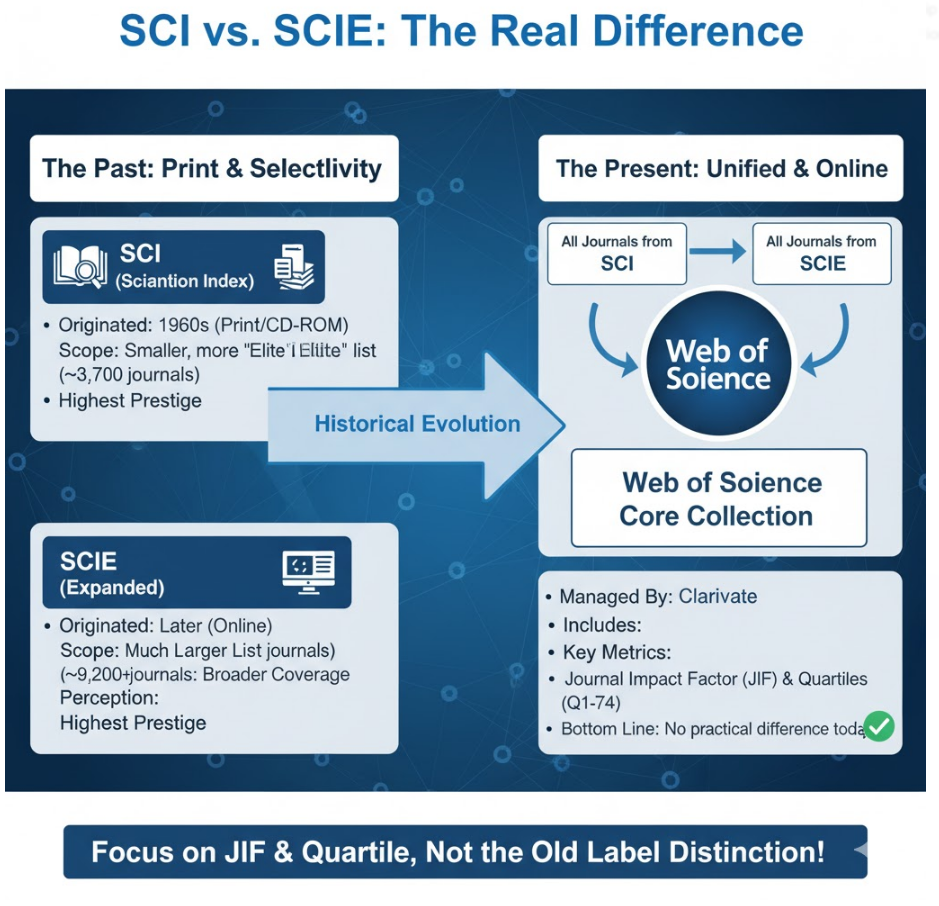In the world of academic publishing, particularly in the sciences, you frequently encounter the terms SCI and SCIE. Journals often highlight their inclusion in these indexes as a mark of quality. But what is the actual difference between the Science Citation Index (SCI) and the Science Citation Index Expanded (SCIE)?
The essential difference is primarily historical and relates to the original format and size of the index. For researchers today, relying on the most current data from Clarivate (the company that manages these indexes), there is effectively no significant difference in quality or prestige between journals listed in SCI versus SCIE. Both are now integral parts of the premier Web of Science Core Collection.

Let's delve into the details.
SCI (Science Citation Index):
Origin: This was the original index created by Eugene Garfield at the Institute for Scientific Information (ISI) in the 1960s.
Format: Initially available in print, and later on CD-ROM.
Scope: It was a more selective list, covering the most highly cited and influential journals in science at the time. The list was relatively smaller (historically around 3,700 journals).
Perception: Because it was the original and more compact list, it was often perceived as being slightly more "elite."
SCIE (Science Citation Index Expanded):
Origin: Developed later, primarily for the online environment as part of the Web of Science (WoS) database.
Format: Exclusively electronic/online.
Scope: As the name suggests, it was an expanded version. It included all the journals from the original SCI plus a significantly larger number of additional high-quality, peer-reviewed journals, covering more regions and emerging scientific fields. The list is much larger (currently over 9,200 journals).
Purpose: To provide broader coverage of the important scientific literature while maintaining rigorous selection criteria.
Here's the crucial point for researchers today:
Clarivate No Longer Differentiates: Clarivate, the company that now owns Web of Science, essentially treats both lists as part of the same high-quality collection for practical purposes, especially concerning the Journal Citation Reports (JCR).
Both Included in WoS Core Collection: Journals listed under the old "SCI" designation and those added under the "SCIE" expansion are all part of the prestigious Web of Science Core Collection. This is the database researchers typically use.
Impact Factors and Quartiles Apply to Both: The calculation of the Journal Impact Factor (JIF) and the assignment of Journal Quartiles (Q1-Q4) in the JCR includes journals from both the historical SCI list and the broader SCIE list. Clarivate has officially stated that for JCR purposes, journals indexed in SCIE are evaluated using the same criteria.
Legacy Perceptions: Some older researchers or institutions might still hold onto the historical perception that the original, smaller SCI list represented a slightly higher tier of prestige.
Journal Marketing: Some journals might still advertise themselves as "SCI-indexed" because it sounds more traditional or elite, even though SCIE is the functionally relevant and larger index today.
When you are evaluating a journal, the practical distinction between SCI and SCIE is largely irrelevant now. What truly matters is:
Is the journal indexed in the Web of Science Core Collection (specifically, the SCIE database)? If yes, it has met Clarivate's high quality standards.
What is its Journal Impact Factor (JIF) and Quartile Ranking (Q1-Q4) within its subject category in the latest JCR? This is the current, universally accepted measure of the journal's relative standing and impact.
So, if a journal says it's "SCI" or "SCIE" indexed, you can generally consider it to be a reputable journal included in the Web of Science Core Collection, eligible for an Impact Factor and quartile ranking. Focus on the actual JIF and Quartile for assessing its prestige today, rather than the outdated SCI/SCIE label difference.